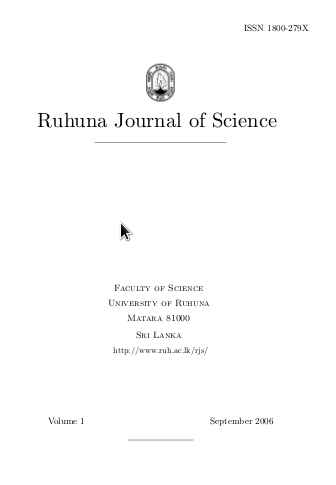Variation of magnetic energy in oriented ultra-thin ferromagnetic films
Abstract
The angle dependence of magnetic energy of ultra-thin films with N=1 to 5 layers has been investigated. The effect of stress and the demagnetization factor on the classical Heisenberg Hamiltonian has been taken into account in addition to other magnetic factors. Films of sc(001) and bcc(001) ferromagnetic indicate preferred in plane and perpendicular orienta- tions for N3 and N4, respectively. Easy and hard directions of all sc(001), bcc(001) and fcc(001) films with five layers are = 7.2°and = 114°respectively. According to our simu- lation, ultra-thin films with one or two layers can be easily oriented in =279°direction.References
Hegde H, Samarasekara P and Cadieu F.J 1994a. Nonepitaxial sputter synthesis of aligned strontium hexaferrites, SrO.6(Fe2O3), films, J. Appl. Phys., 75(10): 6640-6642
Hegde H, Samarasekara P, Rani R, Nanavarathna A, Tracy K, and Cadieu FJ 1994b. Sputter synthesis of TbCu7 type Sm(CoFeCuZr) films with controlled easy axis orientation, J. Appl. Phys. 76(10): 6760-6762
Lederman David, Ricardo Ramirez and Miguel Kiwi 2004. Monte Carlo simulations of exchange bias of ferromagnetic thin films on FeF2(110), Phys. Rev. B70: 184422 1-7
Martin J. Klein and Robert S. Smith 1951. Thin ferromagnetic films, Phys. Rev. 81: 378-380
Navarathna A, Samarasekara P, Hegde H, Rani R and Cadieu FJ 1994. Nitriding studies of aligned high anisotropy ThMn12-type NdFe11Co1-yMoyN film samples, J.Appl.Phys. 76(10): 6068
Samarasekara P, Rani R, Cadieu FJ and Shaheen SA 1996. Variable texture NiOFe2O3 ferrite films prepared by pulsed laser deposition , J. Appl. Phys. 79(8): 5425-5427
Samarasekara P and Cadieu FJ 2001. Magnetic and Structural Properties of RF Sputtered Polycrystalline Lithium Mixed Ferrimagnetic Films , Chinese J. Phys. 39(6): 635-640
Usadel KD and Hucht A 2002. Anisotropy of ultrathin ferromagnetic films and the spin reorientationh transition, Phys. Rev. B 66: 024419 1-6
Downloads
Published
Issue
Section
License
From Volume 7 (2016) onwards, all articles published in Ruhuna Journal of Science are Open Access articles published under the Creative Commons CC BY-NC 4.0 International License. This License permits use, distribution and reproduction in any medium, provided the original work is properly cited and is not used for commercial purposes.
Copyright on any research article published in RJS is retained by the respective author(s).
Authors who publish with this journal agree to the following terms:
a) Authors retain copyright and grant the journal right of first publication with the work simultaneously licensed under a Creative Commons Attribution License CC-BY-NC 4.0 International, that allows others to share the work with an acknowledgement of the work's authorship and initial publication in this journal.
b) Authors are able to enter into separate, additional contractual arrangements for the non-exclusive distribution of the journal's published version of the work (e.g., post it to an institutional repository or publish it in a book), with an acknowledgement of its initial publication in this journal.
c) Authors are permitted and encouraged to post their work online (e.g., in institutional repositories or on their website) prior to and during the submission process, as it can lead to productive exchanges, as well as earlier and greater citation of published work (See The Effect of Open Access).

